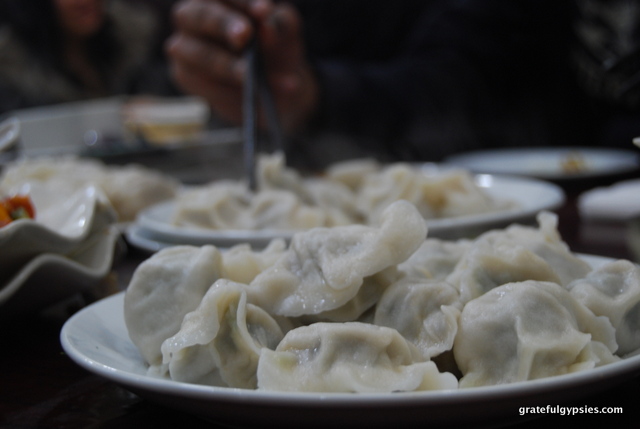All About Dumplings Posted by sasha on Jun 16, 2016 in Culture
Over my 5+ years of living in China, I was often asked about what I missed from home. Aside from the obvious family and friends, food and drink always popped up in the discussion. When I first got to Beijing in 2008, I definitely found myself missing craft beer and certain comfort foods from home. Within a few short years, however, Beijing had numerous micro breweries in addition to a wide array of quality BBQ, pizza, and burger joints to choose from. There was no longer much to miss about home in terms of eating and drinking. When I’d fly back to the US to visit, though, I found myself immediately missing Chinese food. As we’ve discussed at length in our “Real Chinese Food” series, orange chicken and crab rangoons aren’t exactly the real deal. One dish in particular always had me daydreaming – dumplings (饺子 – jiǎo zi).
After so many years of living in China, dumplings definitely became a comfort food for me, just as they are for so many millions of Chinese people. The lengthy process required to make a large batch of dumplings makes it a family affair every time you cook them. That is, assuming you actually do it from scratch and not from a frozen bag as I admittedly often did. Especially on major holidays like the Spring Festival, Chinese people will get together to spend hours in the kitchen preparing a massive amount of dumplings to enjoy eating together on New Year’s Eve. Dumplings represent togetherness, and there’s no better place to be together than over a few hot plates of them. I’m such a fan of Chinese dumplings, I even wrote a love letter to them. Here’s all you need to know about dumplings, including a lot of useful vocabulary:
Different Styles

Mmm…. dumplings.
When it comes to dumplings, you can eat them in many different ways. Here are the three major ways that people cook dumplings:
-
steamed (蒸的 – zhēng de)
-
boiled (煮的 – zhǔ de)
-
fried (炸的 – zhà de)
Beyond the cooking method, there are also a few different types of dumplings out there. You’ve probably heard of wonton soup (馄饨 – hún tún), right? How about the famous xiao long bao (小笼包 – xiǎo lóng bāo) soupy dumplings from Shanghai? Of course, we can’t forget the delectable dim sum (点心 – diǎn xīn) of Cantonese cuisine. However you cook them or prepare them, they’re absolutely delicious.
Common Fillings
There are so many options when it comes to filling dumplings, the possibilities are endless! Here are some of the most common fillings that you’ll find in a plate of dumplings:
-
pork (猪肉 – zhū ròu)
-
beef (牛肉 – niú ròu)
-
lamb (羊肉 – yáng ròu)
-
chicken (鸡肉 – jī ròu)
-
shrimp (虾 – xiā)
-
egg (鸡蛋 – jī dàn)
-
green onion (大葱 – dà cōng)
-
cabbage (白菜 – bái cài)
-
mushroom (香菇 – xiāng gū)
-
leeks (韭菜 – jiǔ cài)
-
celery (芹菜 – qín cài)
-
carrot (胡萝卜 – hú luó bo)
-
tomato (西红柿 – xī hóng shì)
It’s typical to have two fillings in the dumplings – a meat, fish, or egg plus a vegetable. Here are some of the most common combinations you’ll see in restaurants or the supermarket:
-
pork and green onions (猪肉大葱 – zhū ròu dà cōng)
-
leeks and egg (韭菜鸡蛋 – jiǔ cài jī dàn)
-
beef and carrot (牛肉胡萝卜 – niú ròu hú luó bo)
Condiments

Chopstick battle for the last dumpling.
Just as Americans like to put mayo and mustard on a sandwich or burger, Chinese people usually have a few condiments to dip the dumplings in. Here are the typical condiments you’ll pair your dumplings with:
-
soy sauce (酱油 – jiàng yóu)
-
garlic (大蒜 – dà suàn)
-
vinegar (醋 – cù)
-
chili (辣椒 – là jiāo)
If you ask me, the best thing to do is mix them all up in a small dish and then just dump the mix all over your plate of dumplings.
Recipe and Video
By now, I’m sure your mouth is watering. Rather than sit there wishing you had a plate of dumplings to call your own, why not try and whip up a batch yourself? Go ahead and read our post with a great recipe for dumplings, and watch this video while you’re at it:
Big thanks to the Hutong in Beijing for the awesome dumpling-making class and recipe!

Build vocabulary, practice pronunciation, and more with Transparent Language Online. Available anytime, anywhere, on any device.
About the Author: sasha
Sasha is an English teacher, writer, photographer, and videographer from the great state of Michigan. Upon graduating from Michigan State University, he moved to China and spent 5+ years living, working, studying, and traveling there. He also studied Indonesian Language & Culture in Bali for a year. He and his wife run the travel blog Grateful Gypsies, and they're currently trying the digital nomad lifestyle across Latin America.




Leave a comment: